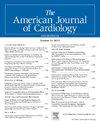One-Year Outcomes in PAD Patients With Elevated Lipoprotein(a): A Propensity-Matched Analysis
IF 2.1
3区 医学
Q2 CARDIAC & CARDIOVASCULAR SYSTEMS
引用次数: 0
Abstract
Lipoprotein(a) (Lp(a)) is a genetically determined, proatherogenic lipoprotein linked to increased cardiovascular risk. Although elevated Lp(a) levels have been implicated in peripheral artery disease (PAD) development, their prognostic significance in patients with established PAD remains unclear. To evaluate whether elevated Lp(a) independently predicts short-term cardiovascular and limb outcomes in patients with established PAD. Using the TriNetX Research Network, we conducted a retrospective cohort study of adults with PAD between January 1, 2010, and January 1, 2025. Patients with Lp(a) measurements were stratified by Lp(a) levels (≥50 mg/dL vs <50 mg/dL). A 1:1 propensity score matching (PSM) controlled for demographics and cardiovascular comorbidities. Primary outcomes included 1-year rates of myocardial infarction, stroke, major adverse cardiovascular events (MACE), all-cause mortality, and major adverse limb events (MALE). Among 1,790,984 PAD patients, 3,397 (0.2%) had elevated Lp(a). After PSM, 2 balanced cohorts of 3,397 patients were analyzed. In the unmatched cohort, elevated Lp(a) was associated with higher rates of myocardial infarction, stroke, and MACE, but paradoxically lower all-cause mortality and major adverse limb events (MALE). However, in the matched cohort, these differences were no longer statistically significant, suggesting the initial findings were likely driven by baseline differences and confounding. In patients with established PAD, elevated Lp(a) was not independently associated with increased short-term cardiovascular or limb events after accounting for comorbidities. These findings suggest that Lp(a)’s prognostic value may be limited in secondary prevention settings but could remain relevant for primary prevention and risk stratification. Further prospective studies are needed to assess the utility of Lp(a)-lowering therapies in PAD populations.
脂蛋白升高的PAD患者1年预后(a):倾向匹配分析
背景:脂蛋白(a) [Lp(a)]是一种基因决定的、致动脉粥样硬化的脂蛋白,与心血管风险增加有关。尽管Lp(a)水平升高与外周动脉疾病(PAD)的发展有关,但其在已确诊的PAD患者中的预后意义尚不清楚。目的:评估Lp(a)升高是否能独立预测已确诊PAD患者的短期心血管和肢体预后。方法:使用TriNetX研究网络,我们对2010年1月1日至2025年1月1日期间患有PAD的成人进行了回顾性队列研究。测量Lp(a)的患者按Lp(a)水平分层(≥50 mg/dL vs.结果:在1,790,984例PAD患者中,3,397(0.2%)患者Lp(a)升高。PSM后,对3397例患者的两个平衡队列进行分析。在未匹配的队列中,升高的Lp(a)与较高的心肌梗死、卒中和MACE发生率相关,但矛盾的是,全因死亡率和男性死亡率较低。然而,在匹配的队列中,这些差异不再具有统计学意义,这表明最初的发现可能是由基线差异和混杂因素驱动的。结论:在确诊的PAD患者中,考虑到合并症后,Lp(a)升高与短期心血管或肢体事件的增加没有独立关联。这些发现表明,Lp(a)的预后价值在二级预防环境中可能有限,但在一级预防和风险分层中可能仍然相关。需要进一步的前瞻性研究来评估降低Lp(a)治疗在PAD人群中的效用。
本文章由计算机程序翻译,如有差异,请以英文原文为准。
求助全文
约1分钟内获得全文
求助全文
来源期刊

American Journal of Cardiology
医学-心血管系统
CiteScore
4.00
自引率
3.60%
发文量
698
审稿时长
33 days
期刊介绍:
Published 24 times a year, The American Journal of Cardiology® is an independent journal designed for cardiovascular disease specialists and internists with a subspecialty in cardiology throughout the world. AJC is an independent, scientific, peer-reviewed journal of original articles that focus on the practical, clinical approach to the diagnosis and treatment of cardiovascular disease. AJC has one of the fastest acceptance to publication times in Cardiology. Features report on systemic hypertension, methodology, drugs, pacing, arrhythmia, preventive cardiology, congestive heart failure, valvular heart disease, congenital heart disease, and cardiomyopathy. Also included are editorials, readers'' comments, and symposia.
 求助内容:
求助内容: 应助结果提醒方式:
应助结果提醒方式:


